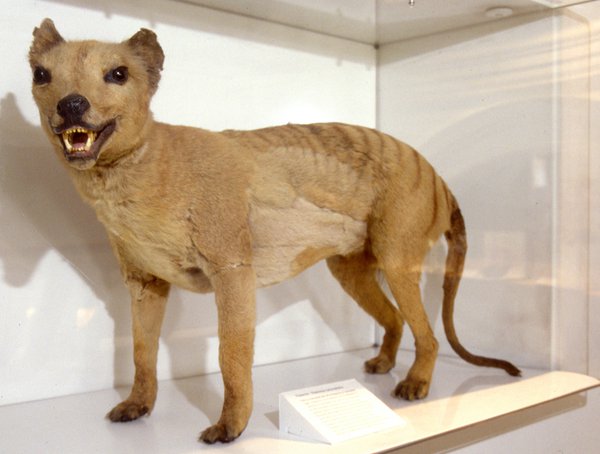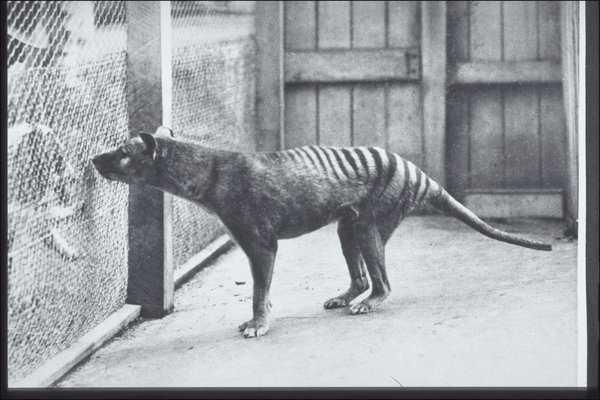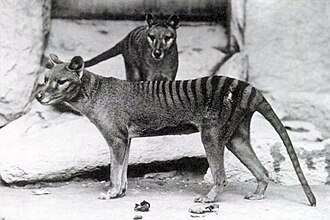The Thylacine (Thylacinus cynocephalus: dog-headed pouched-dog) is a large carnivorous marsupial now believed to be extinct. It was the only member of the family Thylacinidae to survive into modern times.
It is also known as the Tasmanian Tiger or Tasmanian Wolf.
The thylacine (/ˈθaɪləsiːn/; binomial name Thylacinus cynocephalus), The thylacine, also called the Tasmanian tiger or Tasmanian wolf, was a unique carnivorous marsupial that once lived across Australia, Tasmania, and New Guinea. Sadly, it disappeared from New Guinea and mainland Australia about 3,600 to 3,200 years ago — before Europeans even arrived — likely because of the arrival of dingoes, which didn’t make it to Tasmania. Before Europeans settled Tasmania, there were still around 5,000 thylacines living wild on the island. But starting in the 1800s, farmers saw them as a threat to their livestock, and bounty hunting began. The very last thylacine died in 1936 at the Hobart Zoo in Tasmania. Even though they’re gone, thylacines remain a powerful part of Australian culture and are loved as an iconic symbol all across the country.
People mostly blame intensive hunting in Tasmania for the thylacine’s extinction, but there were other factors too — like disease, competition with dingoes, humans moving into their habitats, and even climate changes. Interestingly, the remains of the last known thylacine were found fairly recently, in 2022, at the Tasmanian Museum and Art Gallery. Since they went extinct, there have been plenty of searches and even some reported sightings of live thylacines, but none of those have ever been confirmed.
The thylacine has become a powerful symbol for Tasmania — you’ll even find it on the state’s official coat of arms. Since 1996, Australia has marked National Threatened Species Day every September 7th, which is the anniversary of when the last known thylacine passed away in 1936. People all around the world, from universities to museums, are still fascinated by this unique animal. Scientists have even mapped its entire genome and are working on ways to possibly bring the thylacine back through cloning. Its story reminds us how important it is to protect endangered animals before it’s too late. The thylacine continues to inspire hope and curiosity for wildlife conservation everywhere.

What did it look like?
The thylacine had a sandy yellowish-brown to grey coat, with about 15 to 20 dark stripes running across its back—from the shoulders all the way to the tail. Its head looked a lot like a dog or a wolf, but the tail was stiff, and its legs were pretty short compared to other animals. Its fur was dense, short, and soft—about 15 millimeters long—making it well-suited for its environment.
The thylacine had short, upright ears—about 8 centimeters long—that were rounded and covered with soft, short fur. It had big, strong jaws packed with 46 teeth. Usually, adult male thylacines were a bit bigger than the females.
Female thylacines had a special pouch that opened at the back, where they carried and cared for their babies. They usually had up to four pups at a time, and the little ones stayed close to their mom until they were at least half-grown. Interestingly, even the males had a kind of partial pouch that opened at the back.

What did it eat?
The thylacine was mostly active at night or around dawn and dusk, but sometimes you could spot it during the day too. It moved pretty slowly and with stiff, deliberate steps. When hunting, thylacines usually went out alone or in pairs, mostly under the cover of darkness.
Thylacines mostly liked to hunt kangaroos and other marsupials, along with small rodents and birds. After Europeans arrived, they were said to have gone after sheep and poultry, but this was probably exaggerated. Some of this idea came from a few famous photos taken by Harry Burrell, which made the thylacine look like a bigger threat than it really was.

